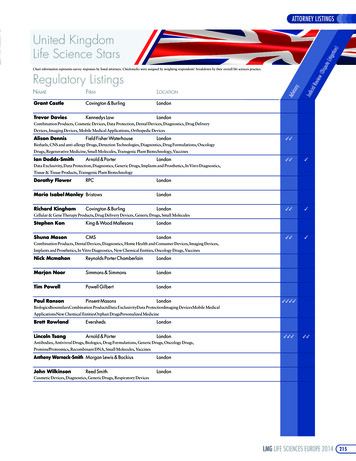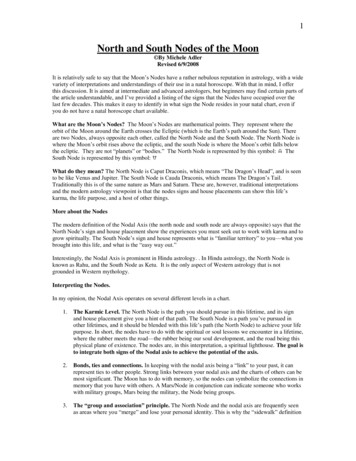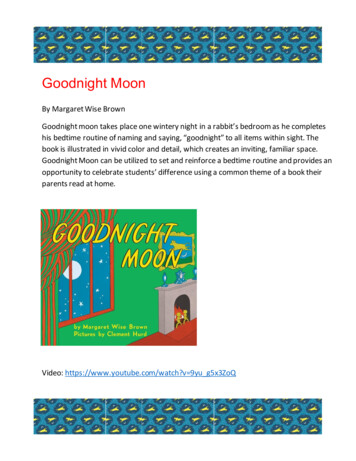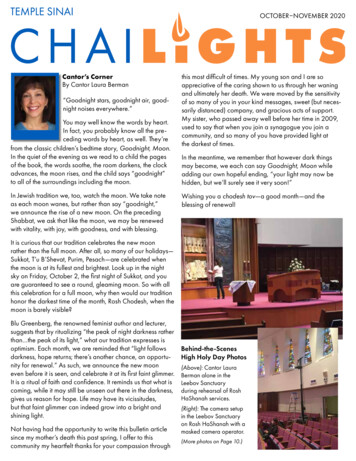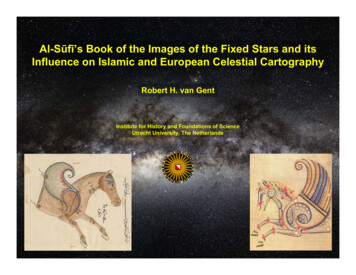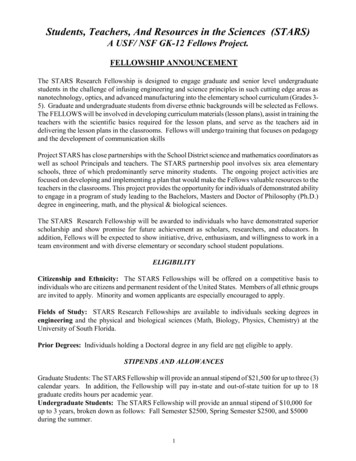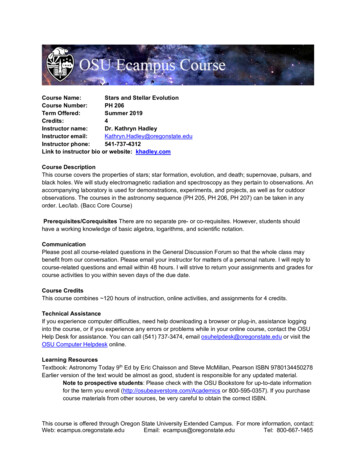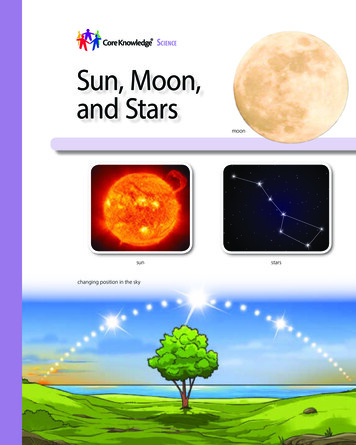
Transcription
SCIENCESun, Moon,and Starsmoonsunchanging position in the skystars
THIS BOOK IS THE PROPERTY OF:STATEBook No.PROVINCEEnter informationin spacesto the left asinstructed.COUNTYPARISHSCHOOL DISTRICTOTHERCONDITIONISSUED TOYearUsedISSUEDRETURNEDPUPILS to whom this textbook is issued must not write on any page or markany part of it in any way, consumable textbooks excepted.1. Teachers should see that the pupil’s name is clearly written in ink in thespaces above in every book issued.2. The following terms should be used in recording the condition of the book:New; Good; Fair; Poor; Bad.
Sun, Moon,and Stars
Creative Commons LicensingThis work is licensed under aCreative Commons Attribution-NonCommercial-ShareAlike4.0 International License.You are free:to Share—to copy, distribute, and transmit the workto Remix—to adapt the workUnder the following conditions:Attribution—You must attribute the work in thefollowing manner:This work is based on an original work of the CoreKnowledge Foundation (www.coreknowledge.org) madeavailable through licensing under a Creative CommonsAttribution-NonCommercial-ShareAlike 4.0 InternationalLicense. This does not in any way imply that the CoreKnowledge Foundation endorses this work.Noncommercial—You may not use this work forcommercial purposes.Share Alike—If you alter, transform, or build upon this work,you may distribute the resulting work only under the same orsimilar license to this one.With the understanding that:For any reuse or distribution, you must make clear toothers the license terms of this work. The best way todo this is with a link to this web /4.0/All Rights Reserved.Core Knowledge , Core Knowledge Curriculum Series ,Core Knowledge Science , and CKSci are trademarksof the Core Knowledge Foundation.Trademarks and trade names are shown in this bookstrictly for illustrative and educational purposes and arethe property of their respective owners. References hereinshould not be regarded as affecting the validity of saidtrademarks and trade names.ISBN: 978-1-68380-585-4Copyright 2020 Core Knowledge Foundationwww.coreknowledge.org
Sun, Moon,and StarsTable of ContentsChapter 1The Mysterious Movement of the Moon . . . 2Chapter 2What Causes Night and Day? . . . . . . . . . . . . . . . . . 6Chapter 3Longer and Shorter Times of Daylight . . . . . . 12Chapter 4Why Does the Moon Seem to Move? . . . . . . . . 16Chapter 5How Does the Starry Sky Change? . . . . . . . . . . . 20Chapter 6Science in Action . . . . . . . . . . . . . . . . . . . . . . . . . . . . . . . 24
CHAPTER1The Mysterious Movementof the MoonIt is early in the morning on a school day. Lin sitsat the kitchen table. It is still dark outside, andhe is tired. It is hard to wake up on these dark,cold mornings! Sleepily, Lin looks out the kitchenwindow. The sky is just beginning to brighten.Lin can see the moon. “It’s morning,” Lin thinks.“Why is it still dark? And why is the moon stillin the sky?”2
Just before dinner that evening, Lin walks his dog, Luna.The sun is setting. It is starting to get dark outside. Lin againnotices the moon in the sky. But it is in a different place. Again,he wonders why the moon is visible when it is not yet night.He thought the moon only came out at night. The appearanceof the sky is changing all the time.3
When he sits down to dinner, Lin looks for the moon throughthe kitchen window. But the moon is not there! Lin saw themoon when he walked Luna just a few minutes ago. He knowsit is in the sky. So why can’t he see it through the windowlike he could at breakfast this morning? He knows he saw themoon this morning when he was sitting in this same spot. Hewas looking through this same window.4
Lin thinks back to the beginning of first grade. The morningswere bright and sunny, not dark. He walked the dog beforebedtime instead of before dinner because it was still lightoutside later in the day.“But where was the moon?” Lin thinks to himself. “Why can Ionly see the moon sometimes? And why does it seem to movefrom place to place?”5
CHAPTER2What Causes Night and Day?Lin saw changes in the day and night sky. Whatcaused these changes? Think about the differencebetween day and night. It’s the sun! When the sunis out, it’s daytime. It is light outside. When the sunis not in the sky, it’s nighttime. It is dark outside.6
To learn about day and night, we first need to understand somethings about Earth, the planet we live on. Earth gets light fromthe sun. The sun is a star!It looks much bigger andbrighter than stars you seein the night sky. That isbecause it is much closerto Earth. Many other starsare larger and brighterthan the sun. They justseem tiny because theyare so far away.7
How do we describe where the sun or moon is in the sky?You have probably heard people use the words north, south,east, west, up, and down. These are directions. Directions let usdescribe the locations of objects or places. They can help ustell where the sun or moon is in the sky.A compass is a tool that tellsdirection.east8
The sun always rises in the east. It appears to move acrossthe sky during the day. Then it sets in the west. One daytimeplus one nighttime make one Earth day. An Earth day istwenty-four hours long. Where Lin lives, the sun rises andsets once in every period of twenty-four hours.Look at the labels for east and west. Can you point to where thesun rises and sets?southwest9
You may be wondering why you cannot see the sun in thesky all the time. We have sunrises and sunsets because Earthis shaped like a ball, and it spins. When one side is facing thesun, the other side is facing away from the sun.10
Only one half of Earth at a time faces the sun. It is light, anddaytime, on that side. It is dark, and nighttime, on the otherside. But as Earth spins, the light side becomes dark. The darkside becomes light. This is why we have night and day. Thispattern happens every twenty-four hours.Where is it daytime in this picture? Where is it nighttime?11
CHAPTER3Longer and Shorter Times of DaylightLin noticed that sometimes it was dark outside whenhe ate breakfast. Sometimes it was light. But he eatsbreakfast at the same time every day. That mustmean that on some days the sun rises earlier. Onsome days it rises later. The length of day and nightchanges throughout the year. If you collect data, youcan see a pattern.12
Think about the changes Lin noticed. Then think aboutwhat you have learned about Earth and the sun. What timeof year do you think it was when it was dark outside in themorning? What time of year do you think it was when hecould walk his dog before bedtime?13
By collecting data, you will see that the sun rises and sets atpredictable times. The times change a little bit each day. Youcan play outside much later in the summer than you can in thewinter. That is because the sun rises very early and sets verylate in the summer. Summer has the most daylight.14
In the fall, days get shorter and shorter. Winter has the leastamount of daylight. The shortest day of the year is in Decemberwhere Lin lives. As winter turns to spring, the amount of timebetween sunrise and sunset slowly grows longer. The longestday of Lin’s year is in June. Then the amount of the daylightslowly decreases as summer turns to fall. The days get shortestin December. This pattern repeats every year.It is the same time of day in both pictures. Why is it brightdaytime in one picture and getting dark in the other?15
CHAPTER4Why Does the Moon Seem to Move?What did Lin notice about the moon? He saw it inthe morning and at night. He saw it when it wasstill light outside. He saw it when it was dark. Hesaw it in different places in the sky.Just like the sun, the moon’s place in the skychanges. And just like the sun, its movementfollows a predictable pattern.16
The moon is very bright against the dark night sky. But it isnot only a night sky object. The moon appears in the skyboth during the day and at night. The sun’s bright lightsometimes makes the moon harder or even impossible to seeduring the day.17
Like the sun, the moon rises and sets. It rises in the easternsky. Then it sets in the west. During the time that the moon isvisible, it appears to move across the sky. Unlike the sun, themoon actually moves! It moves in a path around Earth. Earthalso spins. So the moon’s place in the sky changes.Can you tell if themoon is rising orsetting here? Notunless you knowwhich direction thepicture is facing. Ifthe picture showsa view to the east,which is it?Can you tell if themoon is rising orsetting here? If thepicture shows aview to the west,which is it?18
The moon has the shape of a round ball. Because we seeonly one side of the moon, it sometimes looks like a circle.But sometimes its shape looks different. The moon’s shapechanges over the course of one month. These changeshappen in a predictable pattern. The changes in shape arecalled the moon’s phases.The full moon has acomplete circle shape.The quarter moon is ahalf-circle shape.The crescent moon lookslike the shape of the whitepart of a fingernail.During the new moonphase, the moon is hard tosee. The whole circle is dark.19
CHAPTER5How Does the Starry Sky Change?Lin has figured out that the appearance of the sunand moon changes in the sky. But what about thestars in the sky? Do those change, too?The sun is just one of many billions of stars.Except for the sun, stars are very far from Earth.They are so far away that they look like tiny pointsof light in the sky. You can see stars because theymake their own light.20
Stars are in the sky all the time. But we can only see them atnight. During the day, the sun’s bright light blocks out lightfrom other stars. When the sun sets, the stars show up againstthe dark sky once again.Some stars appear to be larger and brighter than others. Still, itis hard to tell them apart.21
With so many stars in the sky, how can we tell which one iswhich? A long time ago, people imagined picture patternsfrom stars, much like you can connect dots to draw a picture.These star pictures are called constellations.Look at these constellations. What do their shapes make youthink of?Does this looklike a hunter?Does this looklike a scorpion?22
Constellations can contain just a few stars or many stars. TheBig Dipper is one of the easier groups of stars to spot in thenight sky. The Big Dipper contains seven stars. It is shapedlike a ladle. A ladle is a type of deep spoon. The Big Dipper isvisible in the northern night sky.Remember what Lin noticed about objects in the sky. Henoticed the way the positions of the sun and the moonchange. Do you think that the positions of stars change, too?How could you find out?23
CHAPTER6Science in ActionMeeting an AstronomerLin has learned a lot about the objects in the skysince he started noticing them through his kitchenwindow. He knows where the sun rises and sets.Sometimes, Lin sees a full moon. Sometimes, hesees a skinny crescent moon. At other times, hecannot see the moon at all. Lin has made enoughobservations that he knows the pattern. He canpredict how the moon’s shape will appear from oneweek to the next.24
Now Lin is excited to be on a class field trip. The students arevisiting a planetarium. The planetarium is a dark theater. Starsare projected on the curved ceiling. It makes the dome looklike the night sky.The planetarium operator is named Danielle. “The planetariumcan show what the night sky will look like here tonight,”Danielle says. “It can also show what the night sky would looklike on any other night and from any other place on Earth!”25
Danielle explains that scientists who study stars and otherobjects in space are called astronomers. “Astronomers havebeen observing the night sky for thousands of years,” she tellsthe class.“Long ago, people looked at the stars. They noticed thatthey saw different groups of stars during different seasons.They recorded what they saw and discovered patterns. Nowscientists know they can use those patterns to predict whichstars they will see on any night. In a planetarium, we candisplay what that looks like.”26
Astronomers a long time ago recorded what the stars lookedlike in the sky. They made maps of the stars. A planetariumcombines information of many star maps, from many places.Danielle tells the students about some of the first makers ofstar maps. She also tells the students that some of the lights inthe night sky are not stars at all. They are other planets!27
Shi Shen, Gan De, and Wu XianDanielle tells the class about Shi Shen, Gan De, and Wu Xian.They were Chinese astronomers. They lived more than twothousand years ago. They mapped the positions of stars. Theirstar chart used lines to connect groups of stars together intoconstellations. Those constellations are different from the onesLin is used to. They imagined different pictures made fromstars in the night sky.28
GalileoGalileo Galilei was an Italianastronomer. He lived more than fourhundred years ago. Galileo useda telescope to view objects in thenight sky. He looked more closely atthe moon than anyone had before him.Galileo discovered that there were manymore stars in the sky than people had ever seen before.He recorded the way they moved and changed. He foundpatterns. Galileo’s data changed how people thoughtabout the universe.29
CK Sci Core Knowledge SCIENCE Series Editor-in-ChiefE.D. Hirsch Jr.Editorial DirectorsDaniel H. Franck and Richard B. Talbot
Subject Matter ExpertTerri L. Woods, PhDAssociate ProfessorDepartment of GeologyEast Carolina UniversityGreenville, NCIllustration and Photo CreditsAflo Co., Ltd./Alamy Stock Photo: i, iii, 21Alan Novelli/Alamy Stock Photo: 19cAlbum/Alamy Stock Photo: 28Andriy Popov/Alamy Stock Photo: 8aArchimage/Alamy Stock Photo: 25Ashley Cooper pics/Alamy Stock Photo: 19dBLM Photo/Alamy Stock Photo: 18bBrian R. Ewing Photography/Alamy Stock Photo: 17bDavid Giral/Alamy Stock Photo: 26Dennis Hallinan/Alamy Stock Photo: Cover B, 7aDmitrii Korostylev/Alamy Stock Photo: 17aHorizon Images/Motion/Alamy Stock Photo: 20Image Professionals GmbH/Alamy Stock Photo: 18aJames Nesterwitz/Alamy Stock Photo: 14aJonathan Larsen/Diadem Images/Alamy Stock Photo: 19bKevin Ebi/Alamy Stock Photo: 6Llewellyn/Alamy Stock Photo: 15aOlha Rohulya/Alamy Stock Photo: 7bPhotoStock-Israel/Alamy Stock Photo: 27Pictorial Press Ltd/Alamy Stock Photo: 29bRolf Hicker Photography/Alamy Stock Photo: Cover A, 19aScience History Images/Alamy Stock Photo: 29aShaun Cunningham/Alamy Stock Photo: 16Tony Watson/Alamy Stock Photo: 12
CK Sci Core Knowledge SCIENCEA comprehensive program in science, integrating topicsfrom Earth and Space, Life, and Physical Sciences withconcepts specified in the Core Knowledge Sequence(content and skill guidelines for Grades K–8).Core Knowledge SCIENCE units at this level include:Sun, Moon, and StarsPlant and Animal SurvivalExploring Light and SoundSimple MachinesHuman Body Systemswww.coreknowledge.orgISBN: 978-1-68380-585-4Core Knowledge Curriculum Series Series Editor-in-ChiefE.D. Hirsch Jr.
Like the sun, the moon rises and sets. It rises in the eastern sky. Then it sets in the west. During the time that the moon is . visible, it appears to move across the sky. Unlike the sun, the moon actually moves! It moves in a path around Earth. Earth also spins. So the moon’s place in the sky changes. Can
